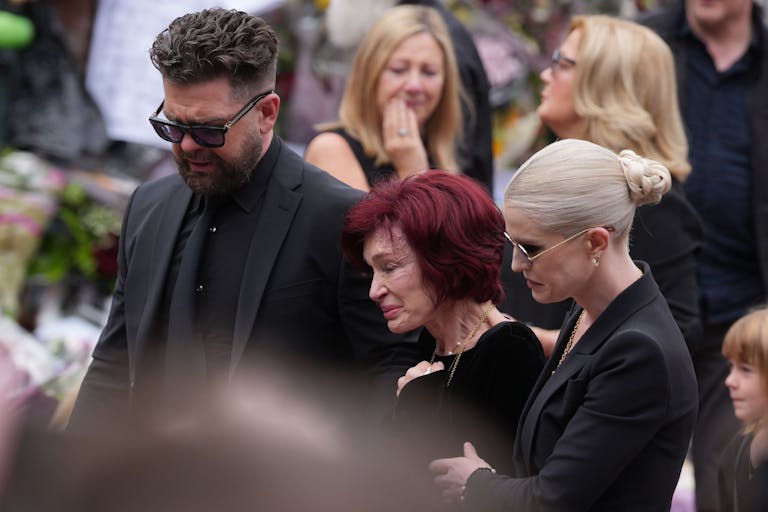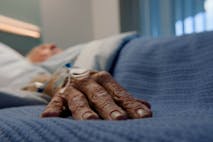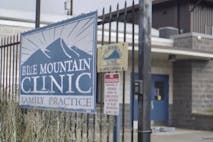
Sharon Osbourne says her kids and grandkids are 'the reason' she's still alive
Cassy Cooke
·
Former abortion clinic workers: The “darkest” room is the recovery room
And Then There Were None is an organization that reaches out to abortion facility workers and helps them leave the abortion industry. On December 22, 2015, ATTWN held a webcast in which several of these former workers shared their stories with former Planned Parenthood manager Abby Johnson, the founder of And Then There Were None.
One of the most poignant parts of the webcast was when former clinic worker Jackie spoke about how women reacted after their abortions. She described how women left the clinic sad and traumatized:
It didn’t matter how confident they were when they walked in, I can’t recall a single patient that walked in with a smile on her face and walked out with a smile. They come in confident or they come in devastated, they go in the procedure room and then they go into a recovery area for about an hour, so when they walk out it’s just varying degrees of quiet sobbing to complete hysteria. We have to give them sedatives and oxygen masks. It’s very evident on their face and in their body that they lost something.
For some women, the quiet moments in the recovery room are the first time they admit to themselves they have lost their babies.
One abortion clinic worker, quoted in the American Medical News back in 1994, said:
[I’ve seen women] who have just had an abortion … lie in the recovery room and cry, ‘I’ve just killed my baby. I’ve just killed my baby.’ I don’t know what to say to these women. Part of me thinks, ‘Maybe they’re right.”1
Some women may have come to the abortion clinic overwhelmed and in crisis mode. But when the abortion is over and they are left to themselves, surrounded by other women who have just had abortions, they may face for the first time the full reality of what they have done and what they have just been through.
In the webcast, Abby Johnson said:
I tell people… that the darkest room, and I don’t mean a light, the darkest, heaviest room in the abortion facility was the recovery room, because it seemed like that was where everybody finally realized what had just happened.
Jackie talked about how the clinic where she worked never allowed women’s partners, the men, to be with them in the recovery room:
Article continues below
Dear Reader,
In 2026, Live Action is heading straight where the battle is fiercest: college campuses.
We have a bold initiative to establish 100 Live Action campus chapters within the next year, and your partnership will make it a success!
Your support today will help train and equip young leaders, bring Live Action’s educational content into academic environments, host on-campus events and debates, and empower students to challenge the pro-abortion status quo with truth and compassion.
Invest in pro-life grassroots outreach and cultural formation with your DOUBLED year-end gift!
Patients did not bring their boyfriends, husbands, fathers, whoever were there to support, they could not bring that person into the back with them. So a lot of women were back there alone.
Alone in the back room of the abortion clinic, how many women went through the aching realization that they had lost their babies, and realized that their lives would never be the same?
Jackie was troubled by the rule that said women were to be separated from their male companions in the recovery room. She asked the clinic manager why they had this policy:
[Y]ou’re taking them back there to remove life from their body, you know, the nicest way to put it, you’ve taken away their support system and our office did that because [I remember] our office manager telling me very specifically it’s because these women want to have a big emotional moment with their partner in the procedure room after they had their abortion, and that takes up too much time. So they need to come out, go to recovery, and then they can have their big moment outside of the clinic or in the lobby out of the way.
Emotional outbursts from the parents of babies who were just aborted would interfere with the abortion clinic’s ability to function. Because the more abortions a clinic commits, the more money it makes, it’s important that nothing slow down the clinic’s operation. It was better to get the women in and out with less fuss. That way the clinic could run smoothly and continue processing women through their abortions and out the door. “Emotional moments” slowed things down – which meant fewer abortions and less profit.
Jackie explains why the women’s time in the recovery room was so emotional:
[O]nce they got to that recovery room, there’s no changing their minds. What’s done is done. And for the most part our patients are back there alone, probably 10 to 15 patients at a time with one nurse. No individual attention. Nothing. And just, when they walk out of that room, and you’re right, it is just, it’s just dark. And they walk out of there, and they’re just drained. Like emotionally drained.
When the women are in the recovery room, the clinic workers do not counsel or comfort them. Any pretense of “counseling” (if there was any) took place before the abortion. After the women have gone through with their abortions, and been sold the “product” the clinic is selling, the clinic is finished with them. The clinic workers send them home to begin what may be a lifelong struggle to come to terms with the deaths of their babies. Ironically, it is usually pro-life groups and ministries that help women pick up the pieces afterward. There are hundreds of thousands of women in various post-abortion groups and ministries throughout the world. Silent No More alone has over 2000 testimonies from women who regret their abortions on its website.
Those dark moments in the clinic’s recovery room may be some of the worst moments in some women’s lives. It is no wonder that Abby Johnson and Jackie call the recovery room the “darkest” room in the clinic.
Notes
Diane M Gianelli, “Abortion Providers Share Inner Conflicts” American Medical News, July 12, 1994
Live Action News is pro-life news and commentary from a pro-life perspective.
Contact editor@liveaction.org for questions, corrections, or if you are seeking permission to reprint any Live Action News content.
Guest Articles: To submit a guest article to Live Action News, email editor@liveaction.org with an attached Word document of 800-1000 words. Please also attach any photos relevant to your submission if applicable. If your submission is accepted for publication, you will be notified within three weeks. Guest articles are not compensated (see our Open License Agreement). Thank you for your interest in Live Action News!

Cassy Cooke
·
Politics
Cassy Cooke
·
Guest Column
Right to Life UK
·
Issues
Angeline Tan
·
Issues
Bridget Sielicki
·
Issues
Nancy Flanders
·
Guest Column
Sarah Terzo
·
Abortion Pill
Sarah Terzo
·
Guest Column
Sarah Terzo
·
Guest Column
Sarah Terzo
·
Guest Column
Sarah Terzo
·